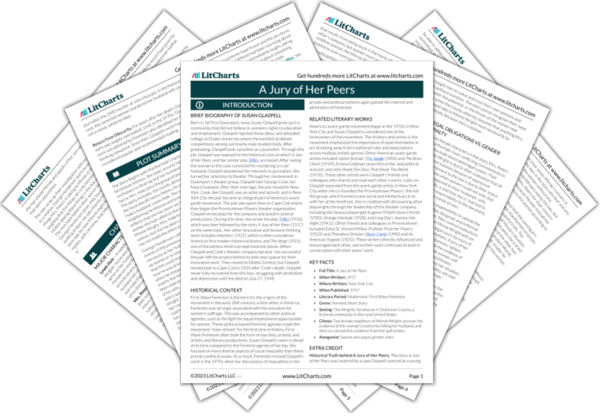The story begins like a murder mystery, in which evidence is sought to convict a culprit. A murder mystery examines a crime, which, when the criminal is caught, is appropriately answered with a punishment. However, in this story, the ideas about what constitutes a crime and how a punishment can or cannot account for a crime are made more complicated. The jury of Minnie Wright’s peers—Mrs. Peters and Martha Hale—judges her to have been justified in her “crime.” Mrs. Peters and Martha Hale conceal the dead bird because they do not believe the legal system will be able to adequately judge and punish the “crime” that was committed. In their eyes, this was not a murder, not the crime one might assume based on that word, but instead was Minnie Foster’s only option given the long standing oppression and isolation she was forced into by her husband and by the social and economic subjugation that defines all the characters’ lives. The women are able to recognize that Minnie Foster’s situation is a special case because, as women, they have experienced these same crimes committed against themselves. Martha Hale says, “we all go through the same things—it’s all just a different kind of the same thing.”
Martha Hale further recognizes that many actions can be crimes that are not acknowledged by a legal system. Therefore, these crimes go unpunished. When she feels guilty for not having visited and assisted Minnie Wright for the last twenty years, she asks, “who’s going to punish that?” While Martha directs this question at herself, her quote also subtly points out that the many crimes of the men in the play also go unpunished because the legal system is blind to the crimes that arise from a system of gender-based oppression and injustice.
Crime and Punishment ThemeTracker

Crime and Punishment Quotes in A Jury of Her Peers
“They think it was such a—funny way to kill a man.”
“That’s just what Mr. Hale said….There was a gun in the house. He says that’s what he can’t understand.”
“Mr. Henderson said, coming out, that what was needed for the case was a motive. Something to show anger—or sudden feeling.”
“‘But he was a hard man, Mrs. Peters. Just to pass the time of day with him—’She stopped, shivered a little. ‘Like a raw wind that gets to the bone’.”
“‘Oh, I wish I’d come over here once in a while!’ She cried. ‘That was a crime! That was a crime! Who’s going to punish that?’”
















